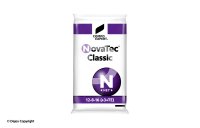As their name suggests, slow release fertilisers distribute a slow and steady amount of nutrients over a period of time.
While some organic slow release fertilisers are available, more often than not these products will be made up of fertiliser that has been coated with a chemical inhibitor. These slow the release of nutrients by altering the natural chemical processes performed by water, heat, sunlight, and soil microbes.
How do slow release fertilisers work?
Slow release fertilisers (SRFs) use chemical inhibitors – such as nitrification inhibitors – to slow the process of turning nutrients into a plant available form. SRFs can release fertiliser over a 10 to 12 week period, dependent on precipitation and temperature, ensuring a more efficient use of the product without the requirement for a polymer coating (as is the case with controlled release fertilisers).
How to use slow release fertilisers
The way you use your slow release fertiliser will usually be dependent on the type of crop you are applying it to and the brand that you decide to work with. There are some general rules that need to be adhered to, though.
For indoor plants and protected ornamentals:
It’s best to use lower application rates of fertiliser during the dormant months of autumn and winter and closely monitor crop growth, then follow seasonal patterns during the growing months in spring and summer.
If your plant is growing quickly, you may want to increase the amount of fertiliser used during this crucial time by adding additional liquid feeds on top of an existing slow release fertiliser.
For outdoor container plants:
For outdoor plants, it’s best to use longer term SRFs and to begin fertilising just before the growing months begin in spring. If you’re planning on transferring your plants, choose a product with a shorter term (around 2-3 months’ effectiveness), or a longer term (around 3-4 months’ effectiveness) if you’re planning to keep them in their containers for the full season. Additional slow release fertiliser can be added as a top dress if required.
For lawns:
During growing months, you can use slow release fertilisers on your lawn around every 10 to 12 weeks, depending on your watering schedule. This will lead to healthier growth and significantly reduce leaching.
How to choose the right slow release fertiliser for your requirements
There are plenty of different slow release fertilisers on the market, each with different purposes and benefits. Some are uniquely designed for trees, shrubs, and perennials, while others may be better suited to indoor plants. The wide range of fertilisers available can make choosing the right product seem like an overwhelming task, but it’s worth exploring your options and committing to the correct product instead of using a standard liquid plant food. Slow release fertilisers will provide nutrients in a more natural and sustainable way than food solutions, and are much less likely to cause root damage. Contact Dejex today for tailored recommendations from our horticultural specialists. ![FLORANID N31 31-0-0 [Regulated Substance]](https://s3-eu-west-1.amazonaws.com/webshop/data/thumbs/64/645207f7f8353b7657ff5cf62abc422469506bbd.jpg)


![FLORANID PERMANENT 4M 16-07-15 (+2MgO) [Regulated Substance]](https://s3-eu-west-1.amazonaws.com/webshop/data/thumbs/bc/bc49e4d9baf5757cc03a0efeaee59ca5ec9f5288.jpg)

![NOVATEC N-MAX 24-5-5+2MgO [Regulated Substance]](https://s3-eu-west-1.amazonaws.com/webshop/data/thumbs/38/3891274653342f3b8b1e1a7cbaf2c2ab781bbab8.jpg)

![NOVATEC 18 N FLUID (AMMONIUM NITRATE LIQUID) [Regulated Substance]](https://s3-eu-west-1.amazonaws.com/webshop/data/thumbs/1c/1c6375b990b4b3829b270b27ba7298a740ad2ef0.jpg)
![NOVATEC SOLUB N-MAX 19-5-5 +2MgO+17S+TE [Regulated Substance]](https://s3-eu-west-1.amazonaws.com/webshop/data/thumbs/58/587101eb2bef772f60f4e9d384bfa6d7083d21bc.jpg)